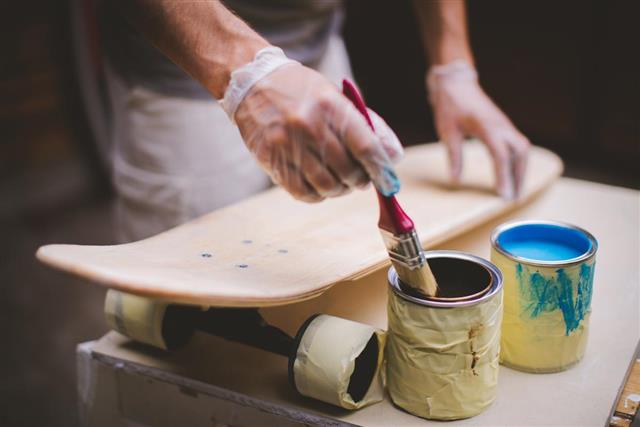
A paint thinner is available in a variety of types, and if you are searching for different ways to use one, you are at the right place. Here are some tips that will make your painting job easy.
A paint thinner is a liquid (solvent) that is capable of dissolving oil-based paints and is used dilute the consistency of a paint that has gone dry. It is also used to clean painting equipment such as brushes, rollers and containers used during the painting. Paint thinners consist of various ingredients, like toluene, turpentine, and acetone. Each of these compounds exhibit different properties, and if you decide to use a paint thinner, you should be aware what the ingredient is. You should also know the safety precautions to undertake to avoid overexposure to solvent fumes or vapors during its use.
Ingredients in a Paint Thinner
Toluene
One of the most commonly used thinners, this aromatic hydrocarbon is usually derived from the tolu balsam tree, hence the name. It is also found naturally in crude oil. It is a highly combustible liquid, and thinners containing toluene should be kept as far as possible from heat sources. Inhalation of toluene vapors can also prove toxic to the human body and can cause dizziness, nausea, tiredness, and irritation in eyes and ears.
Users must be extremely prudent while using it. Protective wear should be donned while handling toluene-based thinners.
Turpentine
Derived from pine trees, turpentine is used in the production of varnishes. It is also a highly flammable liquid and poses a fire hazard, and care should be taken to see that turpentine containers are kept away from heat sources. Turpentine vapors are toxic, and side effects include eye and ear irritation, and if inhaled in large quantities, it can cause respiratory and nervous system disorders, and even result in kidney failure.
Acetone
This is a relatively safer ingredient as compared to other two, and is used widely as a thinner, and is the chief constituent in nail polish removers. It is also very effective in removing adhesives, and is commonly used to remove glue from glass and porcelain surfaces and also to clean make-up accessories. Though it does not pose very high health hazards, it still remains a highly flammable liquid.
Uses
Oil-based paints and vinyl paints each require different types of thinners, so be careful what you use. For a start, pour a little quantity of thinner in the paint which needs to be diluted, and stir well with a wooden spoon or spatula. Continue adding thinner till you reach the desired consistency. Apply a layer of paint to the surface and check, if the paint is not too thick and can be applied properly, or if you need to dilute it further.
To clean painting equipment, pour thinner into a large mixing bowl, and immerse all the brushes, rollers, and other painting tools you have in it. Leave them submerged for a few minutes. Take out the brushes, put them or hang them upright so the excess thinner runs out. Then wrap them in wax paper and store them away. It is also used to restore used brushes which have been lying unused and have hardened over time. Immerse all such brushes in the thinner and let them soak for a few minutes. Swirl around a couple of times. The paint should start loosening and coming off. If there is too much paint, replace the thinner and rinse the equipment again thoroughly. For very stubborn paint you can use a paintbrush comb. Wear gloves and use the pointed teeth of the brush comb to remove hardened paint. Once the paint has completely come off, squeeze out any excess thinner from the painting equipment and set it out to dry. Then wrap the brushes in wax or brown paper to be stored away.
Safety Measures
Always use thinners in a well-ventilated area. Wear protective wear, including eye wear, hand gloves, and face masks to protect yourself from the toxic fumes that paint thinners give off. If at all you start feeling tired and disoriented, stop working and go out in the fresh air. Never allow children, old people, and pets to come anywhere near any painting equipment. Never leave an unused can of thinner open, it gives off highly toxic vapors.
Cover all furniture and other items in the work area with a canvas sheet before you get down to work. Always read the manufacturer’s instructions provided on the can and follow them carefully to avoid any mishaps. Follow the guidelines on the can related to thinner disposal. Do not pour it in the sink or trash can. Unused thinner cans must be tightly sealed and stored away. After you finish using the thinner, wash your hands with soap and water thoroughly.
A relatively simple way to restore the fluidity and usability of your paint, without the danger of losing the color. When used with the right precautions, it can give a fresh lease of life to an old, unused paint.











